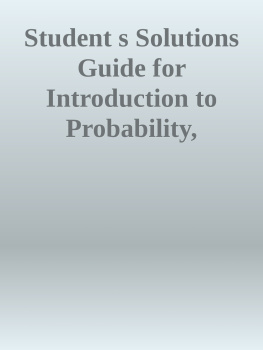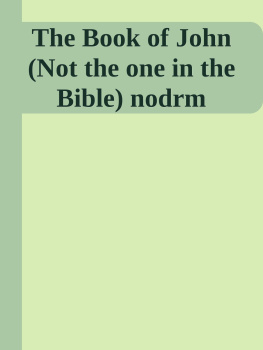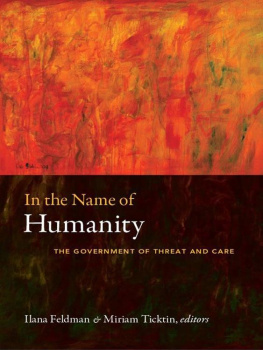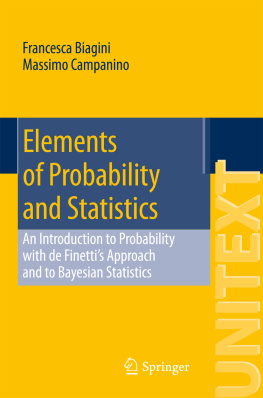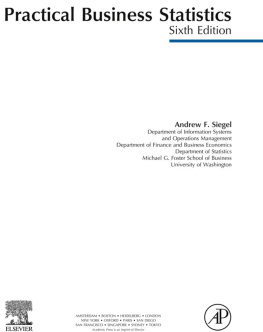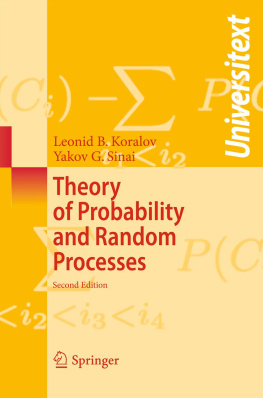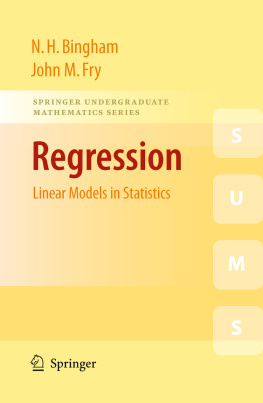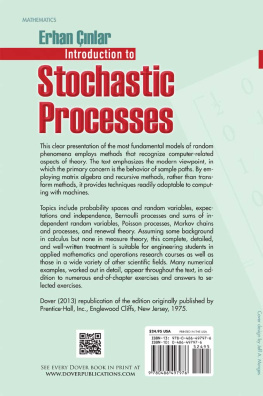Unknown - Student s Solutions Guide for Introduction to Probability, Statistics, and Random Processes nodrm
Here you can read online Unknown - Student s Solutions Guide for Introduction to Probability, Statistics, and Random Processes nodrm full text of the book (entire story) in english for free. Download pdf and epub, get meaning, cover and reviews about this ebook. genre: Children. Description of the work, (preface) as well as reviews are available. Best literature library LitArk.com created for fans of good reading and offers a wide selection of genres:
Romance novel
Science fiction
Adventure
Detective
Science
History
Home and family
Prose
Art
Politics
Computer
Non-fiction
Religion
Business
Children
Humor
Choose a favorite category and find really read worthwhile books. Enjoy immersion in the world of imagination, feel the emotions of the characters or learn something new for yourself, make an fascinating discovery.
Student s Solutions Guide for Introduction to Probability, Statistics, and Random Processes nodrm: summary, description and annotation
We offer to read an annotation, description, summary or preface (depends on what the author of the book "Student s Solutions Guide for Introduction to Probability, Statistics, and Random Processes nodrm" wrote himself). If you haven't found the necessary information about the book — write in the comments, we will try to find it.
Unknown: author's other books
Who wrote Student s Solutions Guide for Introduction to Probability, Statistics, and Random Processes nodrm? Find out the surname, the name of the author of the book and a list of all author's works by series.
Student s Solutions Guide for Introduction to Probability, Statistics, and Random Processes nodrm — read online for free the complete book (whole text) full work
Below is the text of the book, divided by pages. System saving the place of the last page read, allows you to conveniently read the book "Student s Solutions Guide for Introduction to Probability, Statistics, and Random Processes nodrm" online for free, without having to search again every time where you left off. Put a bookmark, and you can go to the page where you finished reading at any time.
Font size:
Interval:
Bookmark:
Students Solutions Guide for Introduction to Probability, Statistics, and Random Processes Hossein Pishro-Nik University of Massachusetts Amherst Copyright c 2016 by Kappa Research, LLC. All rights reserved. Published by Kappa Research, LLC. No part of this publication may be reproduced in any form by any means, without permission in writing from the publisher. This book contains information obtained from authentic sources. Efforts have been made to abide by the copyrights of all referenced and cited material contained within this book.
The advice and strategies contained herein may not be suited for your individual situation. As such, you should consult with a professional wherever appropriate. This work is intended solely for the purpose of gaining understanding of the principles and techniques used in solving problems of probability, statistics, and random processes, and readers should exercise caution when applying these techniques and methods to real-life situations. Neither the publisher nor the author can be held liable for any loss of profit or any other commercial damages from use of the contents of this text. Printed in the United States of America ISBN: 978-0-9906372-1-9 Contents v iii Preface In this book, you will find guided solutions to the odd-numbered end-of-chapter problems found in the companion textbook, Introduction to Probability, Statistics, and Random Processes. Since the textbooks initial publication in 2014, I have received many requests to publish the solutions to those problems.
I have published this book so that students may learn at their own pace with guided help through many of the problems presented in the original text. It is my hope that this book serves its purpose well and enables students to access help to these problems. To access the original textbook as well as video lectures and probability calculators please visit www.probabilitycourse.com. Acknowledgements I would like to thank Laura Handly and Linnea Duley for their detailed review and comments. I am thankful to all of my teaching assistants who helped in various aspects of both the course and the book. v Chapter 1 Basic Concepts 1.
Suppose that the universal set S is defined as S = {1, 2, , 10} and A = {1, 2, 3}, B = {x S : 2 x 7}, and C = {7, 8, 9, 10}. (a) Find A B (b) Find (A C) B (c) Find A (B C) (d) Do A, B, and C form a partition of S? Solution: (a) A B = {1, 2, 3, 4, 5, 6, 7} (b) A C = {1, 2, 3, 7, 8, 9, 10} B = {2, 3, , 7} thus: (A C) B = {1, 8, 9, 10} (c) A = {4, 5, , 10} B C = {2, 3, 4, 5, 6} thus: A (B C) = {2, 3, , 10} CHAPTER 1. BASIC CONCEPTS (d) No, since they are not disjoint. For example, A B = {2, 3} 6= 3. For each of the following Venn diagrams, write the set denoted by the shaded area. (a) (A B) (B A) (b) B C (c) (A B) (A C) (d) (C A B) ((A B) C) 5. (a) (A B) (B A) (b) B C (c) (A B) (A C) (d) (C A B) ((A B) C) 5.
Let A = {1, 2, , 100}. For any i N, define Ai as the set of numbers in A that are divisible by i. For example: A2 = {2, 4, 6, , 100} CHAPTER 1. BASIC CONCEPTS A3 = {3, 6, 9, , 99} (a) Find |A2|,|A3|,|A4|,|A5|. (b) Find |A2 A3 A5|. Solution: (a) |A2| = 50, |A3| = 33, |A4| = 25, |A5| = 20.
Note that in general: |Ai| = b100c, where bxc is the largest integer less than or equal to x. i (b) By the inclusion-exclusion principle: |A2 A3 A5| = |A2| + |A3| + |A5| |A2 A3| |A2 A5| |A3 A5| + |A2 A3 A5|. We have: |A2| = 50 |A3| = 33 |A5| = 20 |A2 A3| = |A6| = 16 |A2 A5| = |A10| = 10 |A3 A5| = |A15| = 6 |A2 A3 A5| = |A30| = 3 |A2 A3 A5| = 50 + 33 + 20 16 10 6 + 3 = 74 7. Determine whether each of the following sets is countable or uncountable. (a) A = {1, 2, , 1010}. (c) C = {(X, Y ) R | x2 + y2 1}. (c) C = {(X, Y ) R | x2 + y2 1}.
Solution: (a) A is countable because it is a finite set. (b) B is countable because we can create a list with all the elements. Specifically, we have shown previously (refer to Figure 1.13 in the book) that if we can write any set B in the form of [ [ B = {qij}, i j where indices i and j belong to some countable sets, that set in this form is countable. For this case we can write [ [ B = {ai + bj 2}. iQ jQ So, we can replace qij by ai + bj 2. (c) C is uncountable.
To see this, note that for all x [0, 1] then (x, 0) C. 9. Let An = [0, 1 ) = {x } for n = 1, 2, . Define n R| 0 x < 1n \ A = An = A1 A2 n=1 Find A. CHAPTER 1. BASIC CONCEPTS Solution: By definition of the intersection A = {x|x An for all n = 1, 2, } We claim A = {0}.
First note that 0 An for all n = 1, 2, . Thus {0} A. Next we show that A does not have any other elements. Since An [0, 1) then A [0, 1). Let x (0, 1). Choose n > 1 then 1 < x.
Thus x / A x n n and this results in x / A. 11. Show that the set [0, 1) is uncountable. That is, you can never provide a list in the form of {a1, a2, a3, } that contains all the elements in [0, 1). Solution: Note that any x [0, 1) can be written in its binary expansion: x = 0.b1b2b3 where bi {0, 1}. Now suppose that {a1, a2, a3, } is a list containing all x [0, 1).
For example: a1 = 0. 1 0101101001 a2 = 0.0 0 0110110111 a3 = 0.00 1 101001001 a4 = 0.100 1 001111001 Now, we find a number a [0, 1) that does not belong to the list. Consider a such that the kth bit of a is the complement of the kth bit of ak. For example, for the above list, a would be a = 0.0100 We see that a / {a1, a2, }. This is a contradiction, so the above list cannot cover the entire [0, 1). 13.
Two teams A and B play a soccer match, and we are interested in the winner. The sample space can be defined as: S = {a, b, d} where a shows the outcome that A wins, b shows the outcome that B wins, and d shows the outcome that they draw. Suppose that we know that (1) the probability that A wins is P (a) = P ({a}) = 0.5, and (2) the probability of a draw is P (d) = P ({d}) = 0.25. (a) Find the probability that B wins. (b) Find the probability that B wins or a draw occurs. (b) P ({b, d}) = P (b) + P (d) = 0.5 15. (b) P ({b, d}) = P (b) + P (d) = 0.5 15.
I roll a fair die twice and obtain two numbers. X1 = result of the first roll, X2 = result of the second roll. CHAPTER 1. BASIC CONCEPTS (a) Find the probability that X2 = 4. (b) Find the probability that X1 + X2 = 7. (c) Find the probability that X1 6= 2 and X2 4.
Solution: The sample space has 36 elements: S = {(1, 1), (1, 2), , (1, 6), (2, 1), (2, 2), , (2, 6), ... (6, 1), (6, 2), , (6, 6)} (a) The event X2 = 4 can be represented by the set. A = {(1, 4), (2, 4), (3, 4), (4, 4), (5, 4), (6, 4)} Thus |A| P (A) = = = |S| (b) B = {(x1, x2)|x1 + x2 = 7} = {(1, 6), (2, 5), (3, 4), (4, 3), (5, 2), (6, 1)} Therefore |6| P (B) = = (c) C = {(X1, X2)|X1 6= 2, X2 4} = {(1, 4), (1, 5), (1, 6), (3, 4), (3, 5), (3, 6), (4, 4), (4, 5), (4, 6), (5, 4), (5, 5), (5, 6), (6, 4), (6, 5), (6, 6)} Therefore |C| = 15 Which results in: P (C) = = . 17. Four teams A, B, C, and D compete in a tournament. Teams A and B have the same chance of winning the tournament.
Team C is twice as likely to win the tournament as team D. The probability that either team A or team C wins the tournament is 0.6. Find the probabilities of each team winning the tournament. Solution: We have P (A) = P (B) P (C) = 2P (D) P (A C) = 0.6 thus P (A) + P (C) = 0.6 P (A) + P (B) + P (C) + P (D) = 1 which results in P (A) = P (B) = P (D) = 0.2 P (C) = 0.4 19. You choose a point (A, B) uniformly at random in the unit square {(x, y) : 0 x, y 1}. CHAPTER 1.
BASIC CONCEPTS y (A, B) B A x What is the probability that the equation AX2 + X + B = 0 has real solutions? Solution: The equation has real roots if and only if: 1 1 4AB 0 i.e. AB . This area is shown here: y x Since (A, B) is uniformly chosen in the square, we can say that the probability of having real roots is area of the shaded region P (R) = area of the square area of the shaded region = To find the area of the shaded region we can set up the following integral: y xy = 0.25 x 0.25 Z 1 1 Area = + dx 4x = + [ln(x)]11 = + ln 4 21. (continuity of probability) For any sequence of events A1, A2, A3, . Prove ! n ! [ [ P Ai = lim P Ai n i=1 i=1 ! n ! \ \ P Ai = lim P Ai n i=1 i=1 Solution: Define the new sequence B1, B2, as B1 = A1 B2 = A2 A1 B3 = A3 (A1 A2) ... i1 ! [ Bi = Ai Aj j=1 CHAPTER 1.
Next pageFont size:
Interval:
Bookmark:
Similar books «Student s Solutions Guide for Introduction to Probability, Statistics, and Random Processes nodrm»
Look at similar books to Student s Solutions Guide for Introduction to Probability, Statistics, and Random Processes nodrm. We have selected literature similar in name and meaning in the hope of providing readers with more options to find new, interesting, not yet read works.
Discussion, reviews of the book Student s Solutions Guide for Introduction to Probability, Statistics, and Random Processes nodrm and just readers' own opinions. Leave your comments, write what you think about the work, its meaning or the main characters. Specify what exactly you liked and what you didn't like, and why you think so.

